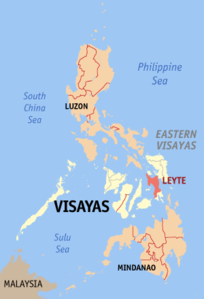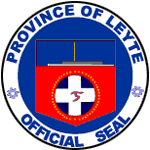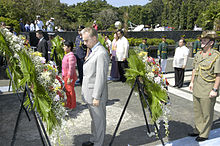Leyte Province
| Basic data | |
|---|---|
| Region : | Eastern Visayas |
| Capital : | Tacloban City |
| Population : | 1,724,679 August 1, 2015 census
|
| Population density : | 292 inhabitants per km² |
| Area : | 5,901.5 km² |
| PSGC : | 083700000 |
| Governor : | Leopoldo Dominico Petilla |
| Official website: | http://www.leyte.org.ph/ |
| structure | |
| - Highly urbanized cities | 2 |
| - provincial cities | 1 |
| - municipalities | 41 |
| - Barangays | 1393 |
| - electoral districts | 5 |
| Location of the province in the Philippines | |

|
|
Coordinates: 10 ° 59 ' N , 124 ° 54' E
The province of Leyte is a province of the island state of the Philippines . It extends over the northern part of the island of Leyte and is one of six provinces in the Eastern Visayas region (Region VIII).
The capital of the province is Tacloban City .
geography
The province of Leyte is the largest province in the Eastern Visayas district and comprises the northern 75% of the island of Leyte . In the east it separates the San Juanico Strait from the neighboring island of Samar , in the south it borders on the province of Southern Leyte and in the north there is the island province of Biliran . To the west of the province, the Camotes Sea opens on the opposite side of which the island of Cebu extends. The province also includes Calangaman Island .
The largest cities are Tacloban City , which is located in the northeast of the province and is also the district center, and Ormoc City in the west. Tacloban City is the oldest of the three cities of Leyte and has an almost metropolitan character.
The province is heavily populated, especially on the coasts, whereas the inland is mountainous and littered with hills. The lowland areas are mostly located in the coastal areas or in the alluvial plains and river deltas that are formed by the large water currents. The largest lowland area is the Leyte-Sab-a-Basin behind the north-eastern central mountain range. The second largest plain is the Ormoc Valley, which extends on the western side of the island framed by mountains. Other lowland areas are smaller and can be found along the coast and near the estuaries to the west and southern Leyte.
Mt. Kankahanay near Jaro is the highest mountain in the province at 1,219 m. An active volcano is located in the province, the 860 meter high Mahagnao .
Leyte has a total area of 5,712.8 km².
Demographics and language
According to the 2007 census, Leyte is home to 1,722,036 people. The province occupies the 24th place of the most populous provinces in the Philippines.
The population density is 301 people per km². This means the 12th place in the country's demographic statistics.
The residents are divided into two main groups, which differ significantly in their language and origin. The Cebuanos live in the west and south, the Waray in the north and east.
The Cebuanos with their dialect Cebuano have historical connections to the islanders of the neighboring island of Cebu , the most populous province of the Visayas. The Waray, on the other hand, have an independent language, the Wáray-Wáray , in common with their neighbors on Samar .
economy
The economic development in the province is largely determined by agriculture. The rice cultivation dominates mainly the lower flatter areas, especially around the capital Tacloban around while coconut trees , in particular the generation serving of coconut oil, have shaped the more mountainous regions.
Fishing is the livelihood of the coastal inhabitants, who have access to species-rich waters around the island and countless fresh water streams in the interior of Leyte.
Political structure
Leyte is divided into 40 independently administered municipalities and 3 cities. These in turn are subdivided into a total of 1,641 barangays (districts).
The province is further divided into five Congress - districts .
Ormoc City is a city independent of the Leyte Province. The city government is fully independent from the provincial administration, just as the residents, which is anchored in the city charter, do not have the right to vote for the election of the provincial government officials.
Cities
Communities
history
Long before the arrival of the Europeans, the Filipinos had trade relations with China and other neighboring countries. On March 28, 1521, the Portuguese navigator and explorer Ferdinand Magellan found a sea route that led its course past Leyte. A little later he reached the island of Limasawa on the southern tip of the island. Here he met the local ruler Rajah Kolambu and his brother Rajah Siagu, the chief of Butu (on Mindanao ).
The explorer Ruy López de Villalobos was the first European to reach the actual island area of Leyte in 1543 and named the island "Las Islas Felipinas" after the Spanish heir to the throne, later King Philip II of Spain.
In 1595 the Jesuits founded their first mission on Leyte. At that time there were only 19 pueblos (villages) with a total population of 70,000 people on the island who were converted to Christianity by the missionaries.
A royal decree, issued July 31, 1860, ordered a reorganization of the provincial government of the entire Visayas group. Leyte was then classified as a third class province and had administrative responsibility for a total of 28 pueblos. The politico-military structure of government existed until the end of Spanish rule in 1898.

On a mission to free the Philippines from Japanese occupation, General Douglas MacArthur led one of the largest naval associations of transport and warships in US history to the Leyte coast. On October 20, 1944, the armed forces, led by McArthur and accompanied by the President of the Commonwealth of the Philippines , Sergio Osmeña , and Carlos P. Romulo, landed in Palo , Leyte, to initiate the liberation of the country. The landing point at which General MacArthur the traditional words "I have returned" (dt. I have returned ) proclaimed, is now one of the most important memorial of the island nation. In addition, there was the Japanese counter-offensive, which culminated in the Battle of Leyte and finally in the greatest naval battle in history, the sea and air battle in the Gulf of Leyte . No fewer than 212 Allied ships encountered around 60 combat ships of the Japanese Navy, including the large battleships Yamato and Musashi .
On May 22, 1959, when Republic Act No. 2227 came into force, the island province was divided into two independent provinces, Leyte and Southern Leyte . A few years later, on May 11, 1992, Biliran was also appointed an autonomous island province and reduced the number of municipalities in its jurisdiction by a further eight localities.
Typhoon Haiyan devastated Leyte province on November 8, 2013 .
climate
There are two climate categories in the province. The east is characterized by climate type II, which is characterized by very heavy rainfall from November to February. The western part belongs to the climatic type IV, whose rainy days can occur more or less all year round. The driest months are from August to September.
Colleges
Attractions
- The gene. Douglas Macarthur Landing Memorial
- The San Juanico Bridge at Tacloban City
- The Sto. Niño Shrine and the Culture Museum in Tacloban City
- The Lake Danao in Ormoc City
- The Breakneck Ridge in Capoocan,
- The Dio Mainland Resort
- The San Juanico Street
- The Red Beach
- The Mahagnao National Park
- Cuatro Islas Protected Landscape / Seascape
- The Tongonan Hotsprings National Park
- Lake Bito on the east coast of Leyte
- The Kuapnit Balinsasayaw National Park
- The main campus of Visayas State University

